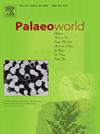Structural analysis of fossilized tree trunks from the Miocene Mydlovary Formation of the South Bohemian Basin (Czech Republic)
IF 1.7
3区 地球科学
Q2 PALEONTOLOGY
引用次数: 0
Abstract
Tree trunks were found in situ in Miocene strata of the Mydlovary Formation of the South Bohemian Basin. Our study presents microscopic and chemical tissue analyses of these tree trunks. The trees were fossilized and flattened. However, they are well preserved, which made the analyses feasible. Good preservation of the tissues is indicated by the high Tissue Preservation Index, the high content of cellulose, and the slightly gelified state of the wood. The Gelification Index indicated that there was only limited alteration during diagenesis. Huminite macerals prevailed over liptinite and inertinite macerals, and two varieties of ulminite and textinite were distinguished, differing in colour reflection, light fluorescence, and reflectance values. The biomarker composition in the extracts of the fossil wood obtained by gas chromatography-mass spectrometry, included terpenoid signatures, supporting a relationship to the Family Cupressaceae s.s.. Gradual burial of the trees is indicated by the fact that they lay crosswise on top of each other. The character of the sedimentary environment and the physiological differences of the trees could explain the deformation and the high degree of preservation.
捷克南波西米亚盆地中新世Mydlovary组树干化石的结构分析
在南波西米亚盆地Mydlovary组中新世地层中原位发现了树干。我们的研究展示了这些树干的显微和化学组织分析。这些树变成了化石,被夷为平地。然而,它们保存得很好,这使得分析变得可行。组织保存良好,组织保存指数高,纤维素含量高,木材呈微胶凝状态。凝胶化指数表明成岩作用过程中仅发生了有限的变化。腐殖岩的显微组织优于脂质岩和惰质岩的显微组织,并区分出铝质岩和织质岩两种不同的显微组织,它们在颜色反射、光荧光和反射率值上存在差异。通过气相色谱-质谱联用分析获得的化石木材提取物的生物标志物组成包括萜类特征,支持其与科柏科植物的关系。这些树被逐渐掩埋的事实表明,它们彼此交叉地躺在一起。沉积环境的特征和树木的生理差异可以解释树木的变形和高度保存。
本文章由计算机程序翻译,如有差异,请以英文原文为准。
求助全文
约1分钟内获得全文
求助全文
来源期刊

Palaeoworld
PALEONTOLOGY-
CiteScore
4.00
自引率
5.90%
发文量
95
期刊介绍:
Palaeoworld is a peer-reviewed quarterly journal dedicated to the study of past life and its environment. We encourage submission of original manuscripts on all aspects of palaeontology and stratigraphy, comparisons of regional and global data in time and space, and results generated by interdisciplinary investigations in related fields. Some issues will be devoted entirely to a special theme whereas others will be composed of contributed articles. Palaeoworld is dedicated to serving a broad spectrum of geoscientists and palaeobiologists as well as serving as a resource for students in fields as diverse as palaeobiology, evolutionary biology, taxonomy and phylogeny, geobiology, historical geology, and palaeoenvironment.
Palaeoworld publishes original articles in the following areas:
•Phylogeny and taxonomic studies of all fossil groups
•Biostratigraphy, chemostratigraphy, chronostratigraphy
•Palaeoecology, palaeoenvironment and global changes throughout Earth history
•Tempo and mode of biological evolution
•Biological events in Earth history (e.g., extinctions, radiations)
•Ecosystem evolution
•Geobiology and molecular palaeobiology
•Palaeontological and stratigraphic methods
•Interdisciplinary studies focusing on fossils and strata
 求助内容:
求助内容: 应助结果提醒方式:
应助结果提醒方式:


